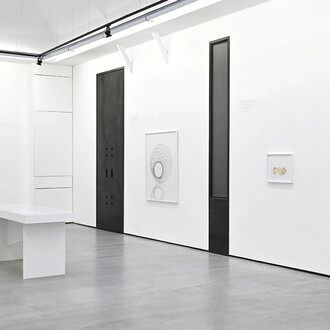Galerie Thaddaeus Ropac is pleased to present an exhibition of new paintings by pioneer conceptual artist Ilya Kabakov. Never shown before, the works dating from 2014-2016 are presented for the first time in Paris. Russian-born and American-based, today Ilya & Emilia Kabakov are recognised as among the most significant international artists to have emerged in the late twentieth century. Considered by curator Robert Storr as ‘one of the great story-tellers of our era’, Ilya Kabakov is known to have fundamentally rethought the nature of ‘conceptual’, ‘environmental’ and ‘performative’ art but also of painting through complex narrative forms. One of the characteristic ways he explores the conceptual potential of narration is through his practice of ‘painted collage’.
The exhibition presents three series that reflect the artist's complex relationship with the past and the notions of personal and collective memory. Ilya Kabakov adopts a new painter’s persona for each series in which different realities overlap.
In the series Two Times (2014-2016) Ilya Kabakov merges visual fragments of soviet imagery with those of seventeenth century Baroque paintings such as Caravaggio’s, The Burial of Saint Lucy (1608) and François de Troy, Portrait de Charles Mouton (1690) in the Louvre. Ilya Kabakov confronts two very different forms of painting, time frames and realities in a single canvas. Since the collapse of the Soviet bloc, the images of happiness, progress and harmony conveyed by stereotyped propaganda have gained a form of folklore quality that is deceptive of its nostalgia. Painted in shapes with torn edges, these images seem to erupt from historical paintings like thoughts that resurface. Ilya Kabakov’s carefully thought-out compositions directly mirror the complexity of our mental space, which intertwines personal and collective memories.
The painting In the Right Direction, Nr 4 (2014) features four different cut-out scenes arranged in sequence: the first shows a ship departing, followed by a 1950s ski resort, then a grand 1930s interior and finally a sunlit nurse. Although the scenes appear as moments of happiness and leisure, the underlying deception of the utopic ideal resonates. The impressionist style of the background reveals the traits of one of the specific personas constructed by Ilya Kabakov. The Flying Painting During the Temporary Loss of Eyesight (2015) series combines abstract motifs of white planes and dots with urban subjects. Here, the artist adopts a character of a painter that longs to create a better reality. The dots refer to earlier works where he added actual candy wrap to signify sweetness, by unifying the surface of the canvas they also show a clear dialogue with conceptual painting. Paris has been of critical importance for Ilya & Emilia Kabakov, as their work achieved universal recognition during Monumenta 2014 with The Strange City at the Grand Palais, Paris and the Dream City at the Power Station in Shanghai in 2015. Other large-scale projects include the Russian Pavilion of the 45th Venice Biennale in 1993, documenta IX, Kassel, Germany in 1992.
This year Ilya & Emilia Kabakov are celebrated worldwide with the major exhibition at Tate Modern: Not Everyone Will be Taken Into the Future (18 October 2017 – 28 January 2018), that will travel to The State Hermitage Museum, St Petersburg and the State Tretyakov Gallery in Moscow in 2018. A survey show of their installation models is currently on view at the Hirshhorn in Washington, DC. In London, Galerie Thaddaeus Ropac is presenting three historic installations: Concert For A Fly (Chamber Music) (1986), Concert For A Fly (1993) and The Fallen Chandelier (1997) until 11 November, 2017.
Ilya Kabakov was born in Dnepropetrovsk, Soviet Union, in 1933. He studied at the V. Surikov Art Academy in Moscow and began his career as a children's book illustrator in the 1950's. At the time, he was also part of a group of conceptual artists in Moscow who worked outside the oficial Soviet art system. In 1985 he had his first solo exhibition in Switzerland, two years after he took up a six months residency at Kunstverein Graz, Austria. In 1988 Ilya Kabakov began working with his future wife Emilia Kabakov. From this point onwards, all their work is collaborative, and changed according to the specific project involved. Today, Ilya and Emilia Kabakov are recognized as the most important Russian artists to have emerged in the late twentieth century.
Emilia Kabakov was born in Dnepropetrovsk, Soviet Union, in 1945. She attended the Music College in Irkutsk in addition to studying Spanish language and literature at the Moscow University. She immigrated to Israel in 1973, and moved to New York in 1975. Emilia Kabakov has worked side by side with Ilya Kabakov since 1989.
















